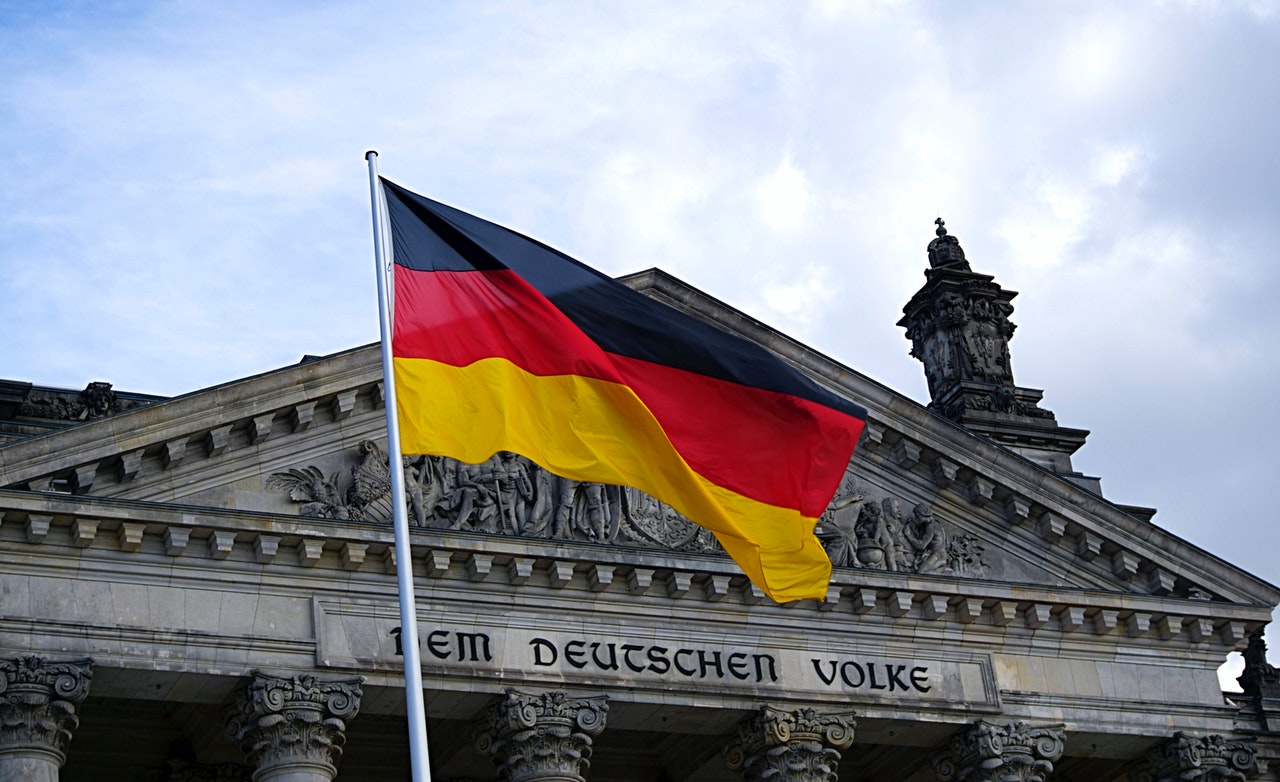History of Germany concept of Germany
History of Germany The concept of Germany
The concept of Germany as a distinct region in central Europe can be traced to Roman commander Julius Caesar, who referred to the unconquered area east of the Rhine as Germania, thus distinguishing it from Gaul (France), which he had conquered. The victory of the Germanic tribes in the Battle of the Teutoburg Forest (AD 9) prevented annexation by the Roman Empire, although the Roman provinces of Germania Superior and Germania Inferior were established along the Rhine. Following the Fall of the Western Roman Empire, the Franks conquered the other West Germanic tribes. When the Frankish Empire was divided among Charles the Great's heirs in 843, the eastern part became East Francia. In 962, Otto I became the first Holy Roman Emperor of the Holy Roman Empire, the medieval German state.
In the Late Middle Ages, the regional dukes, princes, and bishops gained power at the expense of the emperors. Martin Luther led the Protestant Reformation within the Catholic Church after 1517, as the northern states became Protestant, while the southern states remained Catholic. The two parts of the Holy Roman Empire clashed in the Thirty Years' War (1618–1648), which was ruinous to the twenty million civilians living in both parts. The Thirty Years' War brought tremendous destruction to Germany; more than 1/4 of the population and 1/2 of the male population in the German states were killed by the catastrophic war. 1648 marked the effective end of the Holy Roman Empire and the beginning of the modern nation-state system, with Germany divided into numerous independent states, such as Prussia, Bavaria, Saxony, Austria and other states, which also controlled land outside of the area considered "Germany". After the French Revolution and the Napoleonic Wars from 1803–1815, feudalism fell away and liberalism and nationalism clashed with reaction. The German revolutions of 1848–49 failed. The Industrial Revolution modernized the German economy, led to the rapid growth of cities and the emergence of the socialist movement in Germany. Prussia, with its capital Berlin, grew in power. German universities became world-class centers for science and humanities, while music and art flourished. The unification of Germany (excluding Austria and the German-speaking areas of Switzerland) was achieved under the leadership of the Chancellor Otto von Bismarck with the formation of the German Empire in 1871. This resulted in the Kleindeutsche Lösung, ("small Germany solution", Germany without Austria), rather than the Großdeutsche Lösung, ("greater Germany solution", Germany with Austria). The new Reichstag, an elected parliament, had only a limited role in the imperial government. Germany joined the other powers in colonial expansion in Africa and the Pacific.
By 1900, Germany was the dominant power on the European continent and its rapidly expanding industry had surpassed Britain's while provoking it in a naval arms race. Germany led the Central Powers in World War I (1914–1918) against France, Great Britain, Russia and (by 1917) the United States. Defeated and partly occupied, Germany was forced to pay war reparations by the Treaty of Versailles and was stripped of its colonies as well as of home territory to be ceded to Belgium, France, and Poland, and was banned from uniting with German-settled regions of Austria. The German Revolution of 1918–19 put an end to the federal constitutional monarchy, which resulted in the establishment of the Weimar Republic, an unstable parliamentary democracy. In the early 1930s, the worldwide Great Depression hit Germany hard, as unemployment soared and people lost confidence in the government. In January 1933, Adolf Hitler was appointed Chancellor of Germany. His Nazi Party quickly established a totalitarian regime, and Nazi Germany made increasingly aggressive territorial demands, threatening war if they were not met. Remilitarization of the Rhineland came in 1936, then annexation of Austria in the Anschluss and German-speaking regions of Czechoslovakia with the Munich Agreement in 1938, and further territory of Czechoslovakia in 1939. On 1 September 1939, Germany initiated World War II in Europe with the invasion of Poland. After forming a pact with the Soviet Union in 1939, Hitler and Stalin divided Eastern Europe. After a "Phoney War" in spring 1940, German forces swiftly conquered Denmark, Norway, Belgium, Luxembourg, the Netherlands, and France, and forced the British army out of Western Europe. In 1941, Hitler's army invaded Yugoslavia, Greece and the Soviet Union.
Racism, especially antisemitism, was a central feature of the Nazi regime. In Germany, but predominantly in the German-occupied areas, the systematic genocide program known as the Holocaust killed 17 million, including Jews, German dissidents, disabled people, Poles, Romanies, Soviets (Russian and non-Russian), and others. In 1942, the German invasion of the Soviet Union faltered, and after the United States entered the war, Britain became the base for massive Anglo-American bombings of German cities. Overy estimated in 2014 that in all about 353,000 civilians were killed by British and American strategic bombing of German cities, and nine million left homeless.[1] Following the Allied invasion of Normandy (June 1944), the German Army was pushed back on all fronts until the final collapse in May 1945. Under occupation by the Allies, German territories were split up, Austria was again made a separate country, denazification took place, and the Cold War resulted in the division of the country into democratic West Germany and communist East Germany, reduced in territory by the establishment of the Oder-Neisse line. Millions of ethnic Germans were deported from pre-war Eastern Germany, Sudetenland, and from all over Eastern Europe, in what is described as the largest scale of ethnic cleansing in history.[2] Germans also fled from Communist areas into West Germany, which experienced rapid economic expansion, and became the dominant economy in Western Europe. West Germany was rearmed in the 1950s under the auspices of NATO but without access to nuclear weapons. The Franco-German friendship became the basis for the political integration of Western Europe in the European Union.
In 1989, the Berlin Wall was destroyed, the Soviet Union collapsed, and East Germany was reunited with West Germany in 1990. In 1998–1999, Germany was one of the founding countries of the eurozone. Germany remains one of the economic powerhouses of Europe, contributing about one-quarter of the eurozone's annual gross domestic product. In the early 2010s, Germany played a critical role in trying to resolve the escalating euro crisis, especially concerning Greece and other Southern European nations. In the middle of the decade, the country faced the European migrant crisis as the main receiver of asylum seekers from Syria and other troubled regions.
Migration and conquest
Main articles: Germanic peoples and Germania
Further information: Roman governors of Germania Inferior
The expansion of the Germanic tribes 750 BCE – 1 CE (after the Penguin Atlas of World History 1988):
Settlements before 750 BCE
New settlements by 500 BCE
New settlements by 250 BCE
New settlements by 1 CE
Celtic stela, found in the village of Pfalzfeld, (Hunsrück), ca. 400 BCE
The Limes Germanicus border of the Roman Empire and modern boundaries.
The Porta Nigra in Trier, capital of Gallia Belgica, constructed in 170 AD
Fresco with Dionysian scenes from a Roman villa in Colonia Claudia Ara Agrippinensium (modern-day Cologne), 3rd century CE, Romano-Germanic Museum
Map of Germania Inferior – settlements and forts accessible via the navigable rivers, as the hinterland escapes Roman control
The ethnogenesis of the Germanic tribes remains debated. However, for author Averil Cameron it is obvious that a steady process has occurred during the Nordic Bronze Age, or at the latest during the Pre-Roman Iron Age.[20] From their homes in southern Scandinavia and northern Germany the tribes began expanding south, east and west during the 1st century BC,[21] and came into contact with the Celtic tribes of Gaul, as well as with Iranian,[22] Baltic,[23] and Slavic cultures in Central/Eastern Europe.[24]
Factual and detailed knowledge about the early history of the Germanic tribes is rare. Researchers have to be content with the recordings of the tribes' affairs with the Romans, linguistic conclusions, archaeological discoveries and the rather new yet auspicious results of archaeogenetic study.[25] In the mid-1st century BC, Julius Caesar erected the first known bridges across the Rhine during his campaign in Gaul and led a military contingent across and into the territories of the local Germanic tribes. After several days and having made no contact with Germanic troops (who had retreated inland) Caesar returned to the west of the river.[26] The Suebi tribe under chieftain Ariovistus, had around 60 BC conquered lands of the Gallic Aedui tribe to the west of the Rhine. Consequent plans to populate the region with Germanic settlers from the east were vehemently opposed by Caesar, who had already launched his ambitious campaign to subjugate all Gaul. Julius Caesar confronts and beats the Suebi forces in 58 BC in the Battle of Vosges and forces Ariovist to retreat across the Rhine.[27][28]
Collision with the Roman Empire Edit
Emperor Augustus considered conquest beyond the Rhine and the Danube not only regular foreign policy but also necessary to counter Germanic incursions into a still rebellious Gaul. A series of forts and commercial centers were established along the two rivers. Some tribes, such as the Ubii consequently allied with Rome and readily adopted advanced Roman culture. During the 1st century CE Roman legions conducted extended campaigns into Germania magna, the area north of the Upper Danube and east of the Rhine, attempting to subdue the various tribes. Roman ideas of administration, the imposition of taxes and a legal framework were frustrated by the total absence of an infrastructure. The campaigns of Germanicus, for example were almost exclusively characterized by frequent massacres of villagers and indiscriminate pillaging. The tribes, however maintained their elusive identities. In 9 AD a coalition of tribes under the Cherusci chieftain Arminius, who was familiar with Roman tactical doctrines, defeated a sizeable Roman force in the Battle of the Teutoburg Forest. Consequently, Rome resolved to permanently establish the Rhine/Danube border and refrain from further territorial advance into Germania.[29][30] By AD 100 the frontier along the Rhine and the Danube and the Limes Germanicus was firmly established. Several Germanic tribes lived under Roman rule south and west of the border, as described in Tacitus's Germania. These lands represent the modern states Baden-Württemberg, southern Bavaria, southern Hesse, Saarland and the Rhineland. Austria formed the regular provinces of Noricum and Raetia.[31][32][33] The provinces Germania Inferior (with the capital situated at Colonia Claudia Ara Agrippinensium, modern Cologne) and Germania Superior (with its capital at Mogontiacum, modern Mainz), were formally established in 85 AD, after long and painful campaigns as lasting military control was confined to the lands surrounding the rivers.
The 3rd century saw the emergence of a number of large West Germanic tribes: the Alamanni, Franks, Bavarii, Chatti, Saxons, Frisii, Sicambri, and Thuringii. By the 3rd century the Germanic speaking peoples began to migrate beyond the limes and the Danube frontier.[35] Several large tribes – the Visigoths, Ostrogoths, Vandals, Burgundians, Lombards, Saxons and Franks – migrated and played their part in the decline of the Roman Empire and the transformation of the old Western Roman Empire.
Christianity was introduced to Roman controlled southwestern Germania and Christian religious structures such as the Aula Palatina of Trier were built during the reign of Constantine I (r. (306–337 AD). By the end of the 4th century the Huns invaded eastern and central Europe. The event triggered the Migration Period.[37] Hunnic hegemony over a vast territory in central and eastern Europe lasted until the death of Attila's son Dengizich in 469.
Prehistory
The 250,000-year-old Steinheim skull
The discovery of the Homo heidelbergensis mandible in 1907 affirms archaic human presence in Germany by at least 600,000 years ago.[3] The oldest complete set of hunting weapons ever found anywhere in the world was excavated from a coal mine in Schöningen, Lower Saxony. Between 1994 and 1998, eight 380,000-year-old wooden javelins between 1.82 and 2.25 m (5.97 and 7.38 ft) in length were eventually unearthed.[4][5]
In 1856 the fossilized bones of an extinct human species were salvaged from a limestone grotto in the Neander valley near Düsseldorf, North Rhine-Westphalia. The archaic nature of the fossils, now known to be around 40,000 years old, was recognized and the characteristics published in the first-ever paleoanthropologic species description in 1858 by Hermann Schaaffhausen.[6] The species was named Homo neanderthalensis – Neanderthal man in 1864.
The remains of Paleolithic early modern human occupation uncovered and documented in several caves in the Swabian Jura include various mammoth ivory sculptures that rank among the oldest uncontested works of art and several flutes, made of bird bone and mammoth ivory that are confirmed to be the oldest musical instruments ever found. The 40,000-year-old Löwenmensch figurine represents the oldest uncontested figurative work of art and the 35,000-year-old Venus of Hohle Fels has been asserted as the oldest uncontested object of human figurative art ever discovered.
Celtic pottery vessels from a burial site near the Heuneburg
The first groups of early farmers different from the indigenous hunter-gatherers to migrate into Europe came from a population in western Anatolia at the beginning of the Neolithic period between 10,000 and 8,000 years ago.[11]
The settlers of the Corded Ware culture, that had spread all over the fertile plains of Central Europe during the Late Neolithic are of Indo-European ancestry. The Indo-Europeans had, via mass-migration, arrived into the heartland of Europe around 4,500 years ago.
By the late Bronze Age, the Urnfield culture (c. 1300 BC to 750 BC) had replaced the Bell Beaker, the Unetice and Tumulus cultures in central Europe.[13] The Hallstatt culture, which had developed from the Urnfield culture was the predominant Western and Central European culture from the 12th to 8th centuries BC and during the early Iron Age (8th to 6th centuries BC). The people, who had adopted these cultural characteristics are regarded as Celts. How and if the Celts are related to the Urnfield culture remains disputed. However, Celtic cultural centers developed in central Europe during the late Bronze Age (circa 1200 BC until 700 BC). Some, like the Heuneburg at the Danube, grew to become important cultural centres of the Iron Age in Central Europe, that maintained trade routes to the Mediterranean. In the 5th century BC the Greek historian Herodotus mentioned a Celtic city at the Danube - Pyrene, that historians attribute to the Heuneburg. Beginning around 700 BC, Germanic peoples from southern Scandinavia and northern Germany expanded south and gradually replaced the Celtic peoples in Central Europe.







Comments
Post a Comment